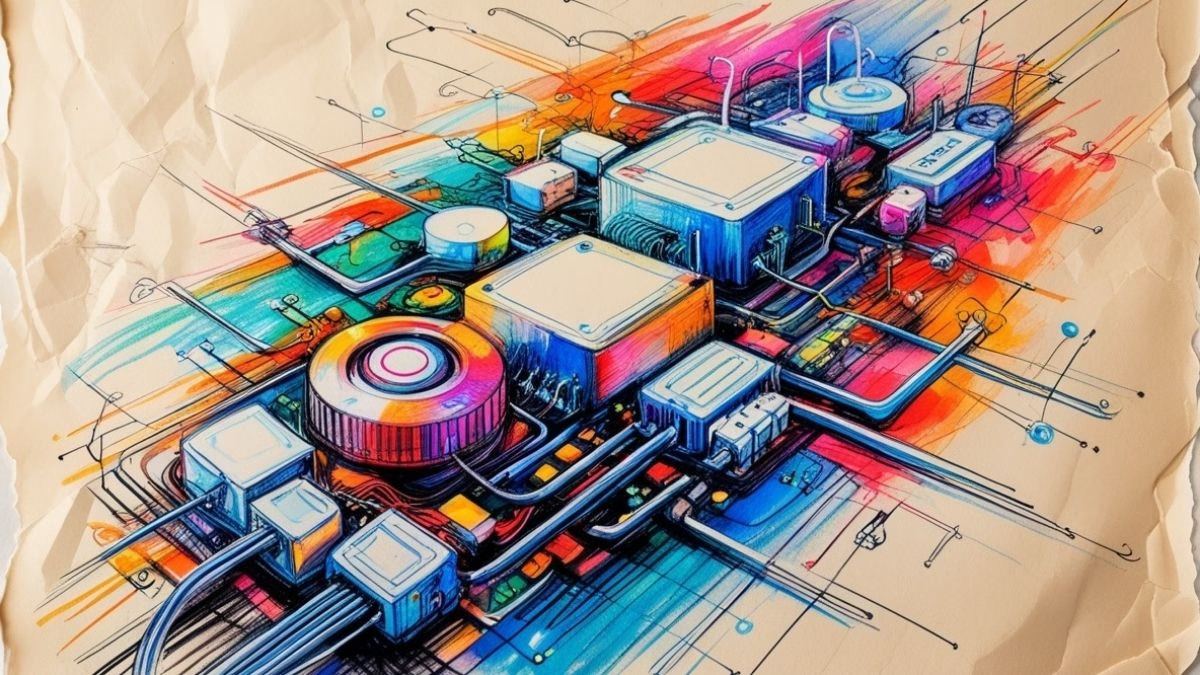Introduction
Your alarm clock doesn’t just buzz. It checks the morning traffic report and wakes you up ten minutes earlier because there’s an accident on your route. As it does, it sends a signal to your coffee maker, which starts brewing your favorite dark roast. The lights in your bedroom slowly fade up to mimic a natural sunrise, and your smart speaker begins to softly play a curated morning playlist while reading you the day’s top headlines and your calendar appointments. You step into the shower, and the water is already at your preferred temperature.
This isn’t a scene from a futuristic sci-fi movie. For a growing number of people, this is just… Tuesday.
We’ve all become acquainted with the “smart” devices that have infiltrated our lives—the watches that track our steps, the thermostats that learn our habits, the doorbells that let us see who’s visiting from halfway across the world. But these gadgets are just the most visible ambassadors of a much larger, quieter, and more profound technological revolution. It’s called the Internet of Things, or IoT, and it’s about far more than just convenience.
It’s a world where virtually every object, from a jet engine to a hospital bed, from a tractor on a farm to a shipping container on the ocean, is being fitted with tiny sensors and a connection to the internet. We are building a global nervous system. We are giving the physical world the ability to see, hear, feel, and communicate. We are teaching it to talk to us, and to talk to itself.
This explosion of connectivity is poised to reshape our world on a scale we haven’t seen since the dawn of the internet itself. But with this monumental power comes monumental questions. Welcome to the episode. Today, we’re plugging into the Internet of Things and trying to understand the ghost in the machine. We’re going on a journey to demystify this ubiquitous buzzword and explore its staggering implications. We’re going to ask the burning questions:
What exactly is the Internet of Things, beyond just a smart toaster that can burn your bread and then tweet about it? How is this technology already running, invisibly, inside our cities, our factories, and our farms to make them more efficient and sustainable? And, of course, we have to talk about the dark side. In a world where everything is connected, how do we protect ourselves from hackers and security threats? When your refrigerator knows your eating habits and your car knows your every move, who owns that data, and what are they doing with it? Are we building a seamless, utopian future, or are we sleepwalking into a privacy nightmare?
This topic is vast and evolving daily, and one podcast episode can only offer a glimpse into this new reality. True comprehension requires ongoing curiosity, a commitment to read beyond the headlines, and a willingness to engage with the complexities. There are no shortcuts to understanding the future. Consider this your orientation, your first step into a much larger, interconnected world.
So, let’s get connected and explore the anatomy of the next digital frontier.
The World is Waking Up: Decoding the Internet of Things (IoT)
So, the Internet of Things. IoT. It sounds intimidatingly technical, but at its core, the concept is surprisingly simple. For most of history, things were just… dumb. A chair was a chair. A streetlamp was a streetlamp. They did their one job and told us nothing. The Internet of Things is the process of taking these everyday, “dumb” objects and giving them a digital brain. It’s about embedding them with sensors, software, and a connection to the internet, allowing them to collect and exchange data.
Think of it like this: we are giving the physical world a nervous system. The sensors are the nerve endings—they can “feel” things like temperature, motion, light, or pressure. The internet connection is the spinal cord, transmitting that sensory information. And the cloud or data centers are the brain, processing that information to make intelligent decisions or trigger actions. An action is carried out by something called an actuator—the part that actually does something, like unlocking a door, turning on a light, or adjusting a valve.
So, the simple formula is: physical object + sensors + connectivity + actuators = a “smart” thing.
Let’s break this down into two main categories. First, there’s the IoT you can see and touch: the Consumer IoT. This is your Nest thermostat, your Amazon Echo, your Apple Watch, your Ring doorbell. These devices are designed to make our lives more convenient, efficient, and personalized. Your fitness tracker monitors your heart rate and sleep patterns, giving you granular data about your health. Your smart fridge can, in theory, tell you when you’re out of milk and add it to your shopping list—though sometimes it feels more like a solution in search of a problem. This is the fun, flashy side of IoT. It’s cool, sometimes a bit gimmicky, but it’s an industry worth hundreds of billions of dollars.
But the real behemoth, the invisible giant that is truly changing the world, is the Industrial and Civic IoT. This is where the technology moves beyond convenience and into transformation.
Take manufacturing. In a “smart factory,” machines are peppered with sensors that monitor their health in real-time. Instead of just waiting for a critical piece of equipment to break down, which could shut down an entire production line for days, the sensors can detect subtle vibrations or temperature changes that indicate a future failure. This is called predictive maintenance. The system can automatically schedule a repair before the breakdown happens, saving millions in downtime.
Or look at agriculture. Farmers are using IoT to deploy sensors across their fields to measure soil moisture, nutrient levels, and acidity. This data is beamed to a central platform, which then tells the irrigation system exactly how much water each specific part of the field needs. No more wasting water by flooding the whole area. Drones can fly over crops with multispectral sensors to identify disease or pests before they’re visible to the human eye. This is precision agriculture, and it allows us to grow more food with fewer resources—a critical task for a growing global population.
Then there are Smart Cities. This is where IoT promises to revolutionize urban living. We’re talking about smart traffic lights that can analyze traffic flow in real-time and adjust their timing to reduce congestion. We’re talking about smart garbage bins that send a notification to the sanitation department when they are full, allowing for more efficient collection routes and preventing overflow. We’re talking about a smart energy grid that can intelligently manage electricity flow from various sources, reducing blackouts and integrating renewable energy more effectively.
This all sounds amazing, right? A seamless, hyper-efficient world where everything just works. And the potential is truly immense. But we have to talk about the flip side of this coin, because every connected device is a double-edged sword.
The first and most obvious risk is security. Every single smart device on a network is a potential door for a hacker. And we’re not just talking about someone messing with your smart lights for fun. In 2016, a massive cyberattack took down huge chunks of the internet by hijacking an army of unsecured IoT devices like webcams and digital recorders. Hackers have demonstrated they can take control of connected cars, and security researchers constantly warn about the vulnerabilities in everything from smart locks to medical devices like insulin pumps. When you connect a hospital’s life-support systems or a city’s power grid to the internet, you have to be absolutely certain that it’s secure. The stakes are terrifyingly high.
The second major concern is privacy. All of these devices are harvesting colossal amounts of data about us. Your smart speaker is always listening for its wake word. Your GPS tracks your location. Your thermostat knows when you are home and when you are away. Your shopping habits, your viewing habits, your health metrics—it’s all being collected, aggregated, and analyzed. This creates a data profile of you that is astonishingly detailed. The burning question is: who owns this data, and what are they doing with it? Is it being used to simply sell you more stuff? Or could it be used by insurance companies to set your premiums, or by potential employers to vet you? The lines are incredibly blurry, and the regulations are struggling to keep up with the pace of technology.
This creates a fundamental tension: the convenience of IoT is often directly proportional to the amount of personal data you’re willing to give up.
Finally, there’s the challenge of interoperability. In a perfect world, your Apple watch would talk flawlessly to your Google Home device which would talk flawlessly to your Samsung smart fridge. In reality, we have a collection of walled gardens. Companies want to lock you into their ecosystem. This lack of a universal standard makes creating a truly seamless smart environment difficult and can be a huge headache for consumers. It also creates problems when cities try to integrate technologies from different vendors. We are still a long way from a universal language for things.
So where is this all headed? The future of IoT is inextricably linked with two other powerhouse technologies: 5G and Artificial Intelligence. The widespread rollout of 5G and future 6G networks will provide the high bandwidth and low latency—meaning faster speeds and less delay—needed to connect billions more devices reliably. AI will be the brain that makes sense of the torrential downpour of data that all these devices will generate, moving from simple automation to true, intelligent decision-making.
The Internet of Things is not a future trend; it is the present. It’s a ubiquitous, invisible layer of technology that is already reshaping our world. It offers a future of unprecedented efficiency, sustainability, and convenience. But it also presents profound challenges to our privacy, security, and autonomy. Our job, as citizens of this new, connected world, is not to be afraid of it, but to be informed. We need to understand the trade-offs, demand accountability from the companies building this future, and thoughtfully decide how much of our lives we are willing to connect to the ghost in the machine.
Focus on Language: Vocabulary & Speaking
Okay, that was a whirlwind tour of our connected future. As you can tell, talking about technology means using some specific and powerful vocabulary. But the great thing is, many of these words, once you understand them, can be used in all sorts of non-technical situations. Let’s slow down and dissect some of the key terms we used, so you can add them to your conversational toolkit.
Let’s start with a word I used to describe the IoT itself: ubiquitous. I said IoT is becoming a “ubiquitous, invisible layer of technology.” Ubiquitous means present, appearing, or found everywhere. It’s a fantastic, high-level word to describe anything that has become incredibly common. For example, “In the 21st century, smartphones have become ubiquitous.” But you can also use it for non-tech things. “Coffee shops are ubiquitous in most major cities,” or “The artist’s style is so popular that imitations have become ubiquitous.” It’s a much more elegant way of saying “everywhere.”
Next up, seamless. We talked about the dream of a “seamless, hyper-efficient world.” Seamless literally means having no seams—no visible lines where two things are joined. Metaphorically, it means smooth and continuous, with no apparent gaps or problems. It’s often used to describe a user experience. “The transition from my phone to my laptop was seamless; all my files were already synced.” You can use it to describe anything that flows perfectly. “The team’s coordination was seamless, leading to a quick victory,” or “She moved between the different topics of her speech in a seamless way.”
Let’s tackle interoperability. It’s a mouthful, I know. We mentioned the challenge of interoperability between devices from different companies. It refers to the ability of different computer systems, devices, or applications to connect and communicate in a coordinated way. In simple terms: can your Apple stuff talk to your Google stuff? But the concept of interoperability is useful elsewhere. Think about different departments in a company. “The lack of interoperability between the marketing and sales software is causing us to lose leads.” Or even in government: “For the new policy to work, there must be interoperability between local and federal agencies.” It’s about different systems working together effectively.
Now for two related tech terms: bandwidth and latency. We said 5G will provide high bandwidth and low latency. In tech terms, bandwidth is the maximum amount of data that can be transmitted over an internet connection in a given amount of time. Think of it like the width of a pipe—a wider pipe allows more water to flow through. Latency is the delay before a transfer of data begins following an instruction. Think of it as the time it takes for the water to start flowing after you turn on the tap. So, high bandwidth and low latency means a very fast, responsive connection.
But you can use these metaphorically! You can talk about your own personal bandwidth. “I’d love to help with that project, but I just don’t have the bandwidth right now.” It means you don’t have the capacity—the time, energy, or mental space—to take on more work. You can also talk about latency in human terms. “There’s a high latency in communication with that department; it takes them days to respond to an email.”
Let’s look at granular. I said your fitness tracker gives you granular data. Granular means resembling or consisting of small grains or particles. When applied to data or information, it means highly detailed, looking at the small, individual components. “The report was too high-level; we need a more granular breakdown of the sales figures by region.” You can use it to describe any detailed approach. “She has a very granular understanding of the historical facts.”
How about vulnerability? We talked about the vulnerabilities in IoT devices. A vulnerability is the quality or state of being exposed to the possibility of being attacked or harmed, either physically or emotionally. In cybersecurity, it’s a flaw that can be exploited by a hacker. It’s a word we use all the time in a personal context. “He showed great vulnerability when he admitted his fears.” or “The country’s reliance on a single food import is a major economic vulnerability.”
We also mentioned predictive maintenance. This is a great concept to understand. It’s using data to detect potential failures before they happen. This idea of being predictive is hugely valuable. You can apply it to your own life. You do predictive maintenance on your car when you change the oil on schedule, rather than waiting for the engine to seize up. You could even apply it to relationships: “Checking in with my friends regularly is a form of predictive maintenance for our friendship.”
Let’s grab a term from the industrial world: legacy systems. While not in the main script, it’s crucial to this topic. A legacy system refers to outdated computing software or hardware that is still in use. Companies often face the challenge of integrating new IoT technology with their old, reliable legacy systems. You can use “legacy” to describe any old way of thinking or operating that’s still around. “The company’s legacy mindset about remote work is holding it back,” or “He’s still using a legacy flip phone from 2005.”
Finally, the word that makes things happen: actuator. We said an actuator is what carries out an action, like unlocking a door. It’s the “muscle” of an IoT device. While it’s a very specific engineering term, it helps to understand that in any system, you have sensors (input) and actuators (output). Thinking this way can clarify any process. What’s the trigger, and what is the action? In a business process, a customer complaint (the sensor input) should trigger an actuator—like a customer service representative making a call (the action output).
So, there we are: ubiquitous, seamless, interoperability, bandwidth, latency, granular, vulnerability, predictive maintenance, legacy systems, and actuator. Powerful words to help you describe our increasingly complex world.
Now, for our speaking challenge. One of the most important communication skills, especially when talking about technology or any complex topic, is the ability to explain it simply using an analogy. An analogy is a comparison between two things, typically for the purpose of explanation or clarification.
For instance, if I wanted to explain the difference between Cloud Computing and Edge Computing in IoT, I could say this: “Think of Cloud Computing like a city’s central library. It’s massive, holds almost all information, but it can take time to travel there to get a book. Edge Computing is like having a small, curated bookshelf right in your living room. It has the books you need most often, and access is instantaneous. You don’t need to go all the way to the library for your favorite novel.” See how that makes an abstract concept feel concrete?
Here is your challenge: Pick a complex topic you understand well. It could be from your job, a scientific concept, a financial strategy, anything. Your mission is to explain it to a friend in 90 seconds or less, using a powerful, simple analogy. Record yourself on your phone. Don’t worry about being perfect. Focus on clarity and creativity. Can you make someone understand something difficult by comparing it to something simple? It’s a superpower for communicators.
Let’s Discuss
Alright, we’ve downloaded a lot of information about the Internet of Things. But the most important part of this conversation is figuring out what it all means for us, as individuals and as a society. That’s where you come in. Here are five questions to spark some thought and discussion. We’d love to see your perspectives in the comments section on our website.
- The Convenience vs. Privacy Trade-Off: Where is Your Line?
From smart speakers to fitness trackers, we are constantly asked to trade our personal data for convenience. Where do you personally draw the line?
- Think about this: Which smart devices are you comfortable having in your home or on your person, and which feel like an invasion of privacy? Is there a type of data (e.g., location, health, conversations) that you would never be willing to share, no matter the benefit?
- The Invisible Watchers: Industrial and Civic IoT
While we worry about our smart speakers, the bigger data collection is happening in our cities and workplaces. What are the biggest potential benefits and dangers of large-scale IoT implementation in public spaces and industries?
- Think about this: Consider the promise of safer, cleaner, more efficient cities. Now, weigh that against the potential for mass surveillance, data breaches, or algorithmic bias in decision-making. Is the trade-off worth it?
- The Security Nightmare: Who Is Responsible?
When a fleet of smart toasters brings down a major website, or a person’s smart lock is hacked, who is ultimately to blame?
- Think about this: Is it the consumer’s responsibility to secure their devices? Should the manufacturer be held liable for shipping a product with security vulnerabilities? Or does the government need to step in and create mandatory security standards for all IoT devices?
- The Skills Gap and the Future of Work
The IoT revolution will create huge demand for new skills (data scientists, cybersecurity experts) while potentially making other jobs obsolete through automation. How should our education systems and societies prepare for this massive shift in the workforce?
- Think about this: What is the responsibility of companies to retrain workers whose jobs are automated? What should schools be teaching children today to prepare them for the jobs of 2040?
- The “Smart” Illusion: When Does a Thing Not Need to be Smart?
We’ve seen a flood of bizarre smart products, from smart water bottles to smart salt shakers. Is there a point where our obsession with connectivity becomes ridiculous?
- Think about this: Discuss the difference between meaningful innovation and technological gimmickry. What makes a smart device genuinely useful versus just a novelty? Share the “smartest” or “dumbest” IoT device you’ve ever encountered.
We’re genuinely curious to hear your opinions on these questions. There are no right or wrong answers, only a fascinating conversation to be had.
Outro
And with that, we’re disconnecting for today. We’ve journeyed from the smart coffee pot on your counter to the vast, invisible network that is quietly rewiring our planet. We hope we’ve given you a clearer picture of the Internet of Things, with all its dazzling promise and its profound perils.
If you want to continue this journey with us, and we certainly hope you do, the best way to do that is by becoming part of the English Plus ecosystem. You can find transcripts for our episodes, deep-dive articles, and engage with our discussion questions on our website at [Your Website Here].
And if you’re enjoying the podcast, the most supportive thing you can do is unlock all of our content by subscribing to English Plus Premium. You can find it right on Apple Podcasts, or on our Patreon page. This gives you access to our entire back catalog of episodes, bonus content, and so much more.
For those of you who want to dive even deeper and offer the next level of support, you can subscribe to our all-access tier on Patreon. That not only includes everything from English Plus Premium, but also gives you access to all of my other audio series and courses, and for those who are interested in my other creative pursuits, you’ll get a front-row seat to my original music and writing. It’s the ultimate way to support the work we do here, and my creative work as a whole.
Thank you for lending us your time and your curiosity today. Until next time, keep learning, keep questioning, and stay thoughtfully connected.










0 Comments